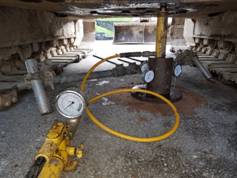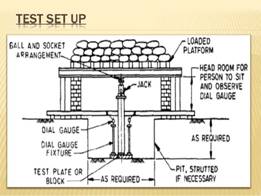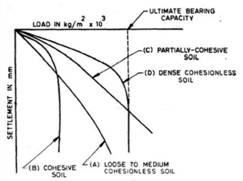This is an in situ test for settlement computation in granular soils. It is difficult to procure the undisturbed samples of granular soils which are non-cohesive. Hence, the laboratory tests cannot be used to obtain the compressibility characteristics of granular soils. Plate Load Test is one of the most frequently used field tests where the test plate simulates a foundation. The method may also be used to evaluate the ultimate bearing capacity, the shear strength and deformation parameters of the soil at the ground surface, in trenches, or in pits.
The plate load test may be carried out in all soils, fills and rocks. The suitable soil for the test is coarse grained and composite soils as well as stiff to firm fine-grained soil. The test should normally not be used for very fine-grained soil. In the progress of the test, care should be taken to ensure that the loading plate is not placed directly on the particles than one-quarter of its diameter.
The plate load test is very useful as it gives results instantly on the field. It serves as a good test for quality control or checking for road compaction, piling mats, haul roads, etc. The test procedure is explained in IS: 1888-1982.

Fig 1: Plate Load Test in the field
Apparatus used:
I. A rough mild steel plate: Rigid plates for performing the test come in different diameters ranging from 30 cm, 45 cm, 60 cm or 75 cm in size, square in shape is used. Since the stress influence zone is generally two times the plate diameter, so it is desirable to use large dimension plates. Generally smaller sizes are used in dense or stiff soils and larger sizes in loose or soft soils.
II. Forc measuring system: A mechanical or electrical force transducer is fitted between the loading plate and the hydraulic jack. It is used to measure the load on the plate.
III. Loading system: Loads on the test plates may be applied by gravity loading or reaction loading. For gravity loading, a platform is constructed on a vertical column resting on the plate. Loading on the plate is given by placing weighed sandbags on the platform. In reaction loading, the load is applied through a proving ring and hydraulic jack by taking reaction against the fixed support.

Fig 2: The test set up and loading
IV. Dial gauges: Dial gauges are used to measure the amount of settlement on the ground caused by reaction loading. Minimum two dial gauges are used. They are mounted on an independent datum bar which is connected to the diametrically opposite ends of the plates. Dial gauges that are capable of measuring settlements to an accuracy of 0.01 mm are used.
The test method:
I. Firstly the test location is selected and depth of the point where the required foundation would be constructed. A pit of dimension not less than five times the width of the plate is excavated up to the proposed depth of foundation.
The test plate is seated at the center over a fine sand layer of a maximum thickness of 5 mm. If the water table is present above the level of the test pit, water is to be pumped out carefully.
II. A seating load of 70 g/cm2 is first applied and released after some time. Loads are applied on the test plate in increments of one-fifth of the estimated safe load up to failure or at least until a settlement of 25 mm has occurred, which is earlier.
At each load, the settlement is recorded at a time interval of 1, 2.25, 4, 6.25, 9, 16, and 25 minutes and thereafter an interval of one hour. For clayey soil, the load is increased when the time settlement curve indicates that the settlement has exceeded 70 to 80 percent of probable ultimate settlement. For soils other than clayey soil the load is increased when the rate of settlement drops to a value less than 0.02 mm/min.
III. The load-settlement curve can be plotted for the test plate from the test data.
In 1948, Terzaghi and Peck have recommended that settlement of a footing on cohesionless soil can be obtained by extrapolating from the settlement experienced by a test plate at the same load intensity. The supporting equation is

where
Sf = settlement of a foundation of width Bf (cm)
Sp = settlement of the test plate of width Bp (cm) at the load intensity as on the foundation.
Some important considerations to be kept in mind during the test are:
- The test plate should not be smaller than 30 cm in any case. Because experiments show that load settlement behaviour of soil is qualitatively different for smaller widths of test plates as compared to a larger width.
- Settlement of a foundation cannot exceed about four times of settlement of a plate of 30 cm width or more.
- If the soil at the site is not homogeneous up to a considerable depth of the foundation, the plate load test may lead to misleading results. Therefore, a plate load test is to be supplemented by adequate soil exploration through a borehole which reveals the soil condition up to a depth of 1.5 or 2 times of the width of the foundation.
- The effect of capillarity is to increase the effective vertical stress or its stiffness. A test plate resting on sand bed undergoes smaller settlement than a plate resting on the dry or submerged sand bed.
- Practically, a plate load test should be performed at the water table level within 1 meter below the foundation.
For clay soil
Plate Load Test is of short period. It measures the immediate settlement only. In sandy soil immediate settlement is taken as the total settlement. While for clayey soil we take total settlement as consolidation settlement which cannot be predicted through this test. As the settlement criterion is very important in the determination of allowable bearing pressure of a foundation, this test is not much relevant for clayey soil. The equation which is recommended for settlement of foundation in clayey soil is

The load-settlement cure obtained from a plate load test can be used to determine the ultimate bearing capacity and the safe bearing pressure of foundations. In the year 1980, Rao and Ramasamy recommended that the safe bearing pressure corresponding should be 50 percent of the ultimate bearing capacity of the test plate. If the test is carried out above the natural water table, the settlement curve will have to be corrected if there is any possibility of rising in the water table in the future.

Fig 3: A typical load settlement curve
If you have a query, you can ask a question here.



I want to know the principle behind the Benkelman field test for compaction test on road foundation as a control test